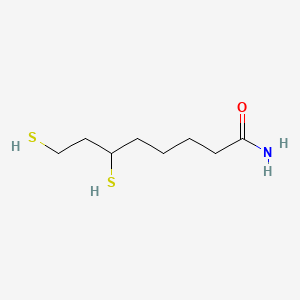| MeSH term | MeSH ID | Detail |
|---|---|---|
| Parkinsonian Disorders | D020734 | 20 associated lipids |
Dihydrolipoamide
Dihydrolipoamide is a lipid of Fatty Acyls (FA) class. Dihydrolipoamide is associated with abnormalities such as Wiskott-Aldrich Syndrome. The involved functions are known as Citric Acid Cycle, Electron Transport, NADH oxidation, Oxidation and Oxidants. Dihydrolipoamide often locates in Mitochondria, Mitochondrial matrix and Chloroplasts. The associated genes with Dihydrolipoamide are Mutant Proteins, Recombinant Proteins, mycothione reductase, Genes, Mitochondrial and alanylproline.
Cross Reference
Introduction
To understand associated biological information of Dihydrolipoamide, we collected biological information of abnormalities, associated pathways, cellular/molecular locations, biological functions, related genes/proteins, lipids and common seen animal/experimental models with organized paragraphs from literatures.
What diseases are associated with Dihydrolipoamide?
Dihydrolipoamide is suspected in and other diseases in descending order of the highest number of associated sentences.
Related references are mostly published in these journals:
| Disease | Cross reference | Weighted score | Related literature |
|---|
Possible diseases from mapped MeSH terms on references
We collected disease MeSH terms mapped to the references associated with Dihydrolipoamide
PubChem Associated disorders and diseases
What pathways are associated with Dihydrolipoamide
There are no associated biomedical information in the current reference collection.
PubChem Biomolecular Interactions and Pathways
Link to PubChem Biomolecular Interactions and PathwaysWhat cellular locations are associated with Dihydrolipoamide?
Visualization in cellular structure
Associated locations are in red color. Not associated locations are in black.
Related references are published most in these journals:
| Location | Cross reference | Weighted score | Related literatures |
|---|
What functions are associated with Dihydrolipoamide?
Related references are published most in these journals:
| Function | Cross reference | Weighted score | Related literatures |
|---|
What lipids are associated with Dihydrolipoamide?
There are no associated biomedical information in the current reference collection.
What genes are associated with Dihydrolipoamide?
Related references are published most in these journals:
| Gene | Cross reference | Weighted score | Related literatures |
|---|
What common seen animal models are associated with Dihydrolipoamide?
There are no associated biomedical information in the current reference collection.
NCBI Entrez Crosslinks
All references with Dihydrolipoamide
Download all related citations| Authors | Title | Published | Journal | PubMed Link |
|---|---|---|---|---|
| McMillan PJ et al. | The human malaria parasite Plasmodium falciparum possesses two distinct dihydrolipoamide dehydrogenases. | 2005 | Mol. Microbiol. | pmid:15612914 |
| de Graaf RM et al. | The organellar genome and metabolic potential of the hydrogen-producing mitochondrion of Nyctotherus ovalis. | 2011 | Mol. Biol. Evol. | pmid:21378103 |
| Fairlamb AH et al. | The interaction of arsenical drugs with dihydrolipoamide and dihydrolipoamide dehydrogenase from arsenical resistant and sensitive strains of Trypanosoma brucei brucei. | 1992 | Mol. Biochem. Parasitol. | pmid:1501642 |
| Deringer JR et al. | Immunoreactive Coxiella burnetii Nine Mile proteins separated by 2D electrophoresis and identified by tandem mass spectrometry. | 2011 | Microbiology (Reading, Engl.) | pmid:21030434 |
| Sastalla I et al. | Activation of the latent PlcR regulon in Bacillus anthracis. | 2010 | Microbiology (Reading, Engl.) | pmid:20688829 |
| Gallo G et al. | Differential proteomic analysis highlights metabolic strategies associated with balhimycin production in Amycolatopsis balhimycina chemostat cultivations. | 2010 | Microb. Cell Fact. | pmid:21110849 |
| Lu X et al. | The intra- and extracellular proteome of Aspergillus niger growing on defined medium with xylose or maltose as carbon substrate. | 2010 | Microb. Cell Fact. | pmid:20406453 |
| Peano C et al. | Comparative genomics and transcriptional profiles of Saccharopolyspora erythraea NRRL 2338 and a classically improved erythromycin over-producing strain. | 2012 | Microb. Cell Fact. | pmid:22401291 |
| Yao R et al. | Catabolic regulation analysis of Escherichia coli and its crp, mlc, mgsA, pgi and ptsG mutants. | 2011 | Microb. Cell Fact. | pmid:21831320 |
| Patel MS and Hong YS | Lipoic acid as an antioxidant. The role of dihydrolipoamide dehydrogenase. | 1998 | Methods Mol. Biol. | pmid:9921542 |
| Patel MS et al. | Dihydrolipoamide dehydrogenase: activity assays. | 1995 | Meth. Enzymol. | pmid:7476353 |
| Yan LJ et al. | Changes in dihydrolipoamide dehydrogenase expression and activity during postnatal development and aging in the rat brain. | 2008 | Mech. Ageing Dev. | pmid:18316113 |
| ChavarrÃa M et al. | Regulatory tasks of the phosphoenolpyruvate-phosphotransferase system of Pseudomonas putida in central carbon metabolism. | 2012 | MBio | pmid:22434849 |
| Koti RS et al. | Effect of ischemic preconditioning on hepatic microcirculation and function in a rat model of ischemia reperfusion injury. | 2002 | Liver Transpl. | pmid:12474159 |
| Shaco-Levy R et al. | On appropriate pathology for photothermal surgery. | 2004 | Lasers Surg Med | pmid:15278925 |
| Holbrook ED et al. | Definition of the extracellular proteome of pathogenic-phase Histoplasma capsulatum. | 2011 | J. Proteome Res. | pmid:21291285 |
| Campanucci VA et al. | A novel O2-sensing mechanism in rat glossopharyngeal neurones mediated by a halothane-inhibitable background K+ conductance. | 2003 | J. Physiol. (Lond.) | pmid:12640017 |
| Ramos EI et al. | 2,3-diphenyl-1,4-naphthoquinone: a potential chemotherapeutic agent against Trypanosoma cruzi. | 2009 | J. Parasitol. | pmid:18788881 |
| Starkov AA et al. | Mitochondrial alpha-ketoglutarate dehydrogenase complex generates reactive oxygen species. | 2004 | J. Neurosci. | pmid:15356189 |
| Klivenyi P et al. | Mice deficient in dihydrolipoamide dehydrogenase show increased vulnerability to MPTP, malonate and 3-nitropropionic acid neurotoxicity. | 2004 | J. Neurochem. | pmid:15009635 |
